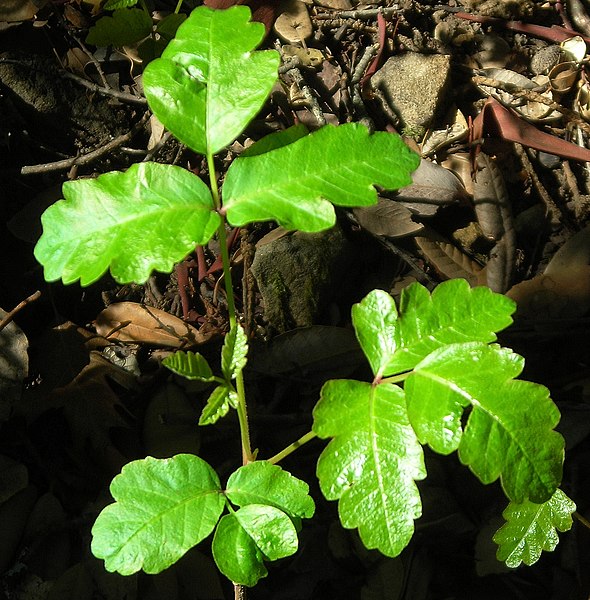There are two types of poison oak in the United States; both Atlantic and Pacific poison oak cause severe dermatitis in people allergic to it. Although the Atlantic poison oak plant looks relatively harmless it isn't. People that come in contact with it get a terrible itchy rash that worsens as it progresses. Some people develop bumps and blisters that ooze, and hives may also develop. Some folks are so allergic to this plant that they may require a trip to the hospital. The rash usually appears a day or two after exposure and can last about a week. Although many Native American communities considered this plant "poisonous" they did find ways to use it medicinally.
Toxicodendron pubescens, commonly known as Atlantic poison oak is a species native to the Southeastern United States from Virginia westward to Texas and Oklahoma. This plant grows in woodland areas where it easily blends into the landscape and in dry sandy fields. Poison oak is a shade-loving plant that has three leaflets per branch and as many as nine leaflets per cluster. In the spring the leaves are red or green and have greenish-yellow flowers. During the summer months, the leaves are green and some plants produce light green berries, and in the autumn, the leaves turn various shades of red and orange.
Inconceivably, Native American communities found limited medicinal use for this plant. For example, the Cherokee made a decoction of the stems of this plant and took it as an emetic. The Delaware made a poultice of roasted, crushed roots and used it to treat rheumatism and stiffness. They also made a salve from crushed roots to treat chronic sores and swollen glands. The Iroquois made a poultice of the entire plant and applied it to infectious sores on the lips. They also used a decoction of the plant as a pediatric aid and gave it to high-strung children. The Meskwaki made a poultice of the pounded root and treated swellings to cause blisters. The Potawatomi Medicine Men made a poultice of the pounded root and applied it to swellings. Some Native American communities prescribed acrid juice from fresh leaves for its stimulant and narcotic properties.
Alaska and Hawaii don't have poison ivy, poison oak, or poison sumac.
Poison Oak was introduced into England in the 1640s, it was not used in medicine there until the end of the 18th century when it was utilized in the treatment of stubborn herpetic eruptions.
At one-time poison oak was officially listed in the Pharmacopoeia of the U.S.
Both the Atlantic and Pacific forms of poison oak contain a chemical called urushiol, which most people are allergic to. Coming in contact even with dead leaves, stems or roots can cause a severe reaction to this oil.
Burning Atlantic poison oak releases the oil into the air where it can trigger internal and external allergic reactions. To inhale this oil is extremely dangerous.
Some people are so allergic that they have trouble breathing and swallowing. In severe cases, it can cause swollen lymph nodes, headaches, and nausea.
_(4-5-08)_canet_-1_(2391067502).jpg)

,_San_Luis_Obispo_-2_(535341428).jpg)
Informative! Thank you, Janet and The Institute for American Indian Studies. Makes one remember there is nothing growing on this beautiful planet that does not have value and beauty.
ReplyDelete